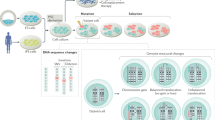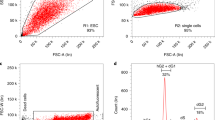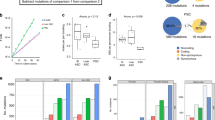Abstract
The study of Ataxia-telangiectasia (A-T) has benefited significantly from mouse models with knockout mutations for the Atm (A-T mutation) locus. While these models have proven useful for in vivo studies, cell cultures from Atm null embryos have been reported to grow poorly and then senesce. In this study, we initiated primary cultures from adult ears and kidneys of Atm homozygous mice and found that these cultures immortalized readily without loss of sensitivity to ionizing radiation and other Atm related cell cycle defects. A mutational analysis for loss of expression of an autosomal locus showed that ionizing radiation had a mutagenic effect. Interestingly, some spontaneous mutants exhibited a mutational pattern that is characteristic of oxidative mutagenesis. This result is consistent with chronic oxidative stress in Atm null cells. In total, the results demonstrate that permanent cell lines can be established from the tissues of adult mice homozygous for Atm and that these cell lines will exhibit expected and novel consequences of this deficiency.
This is a preview of subscription content, access via your institution
Access options
Subscribe to this journal
Receive 50 print issues and online access
$259.00 per year
only $5.18 per issue
Buy this article
- Purchase on Springer Link
- Instant access to full article PDF
Prices may be subject to local taxes which are calculated during checkout





Similar content being viewed by others
References
Barlow C, Hirotsune S, Paylor R, Liyanage M, Eckhaus M, Collins F, Shiloh Y, Crawley JN, Ried T, Tagle D, Wynshaw-Boris A . 1996 Cell 86: 159–171
Cole J, Arlett CF, Green MHL, Harcourt SA, Priestley A, Henderson L, Cole H, James E, Richmond F . 1988 Int. J. Radiat. Biol. 54: 929–943
Cooper GE, DiMartino DL, Turker MS . 1991 Somat. Cell. Mol. Genet. 17: 105–116
Cooper GE, Khattar NH, Bishop PL, Turker MS . 1992 Somat. Cell. Mol. Genet. 18: 215–226
Dickerman LH, Tischfield JA . 1978 Mutat. Res. 49: 83–94
Elson A, Wang Y, Daugherty CJ, Morton CC, Zhou F, Campos-Torres J, Leder P . 1996 Proc. Natl. Acad. Sci. USA 93: 13084–13089
Freyer GA, Palmer DA, Yu Y, Miller RC, Pandita TK . 1996 Mutat. Res. 357: 237–244
Gatei M, Shkedy D, Khanna KK, Uzeil T, Shiloh Y, Pandita TK, Lavin MF, Rotman G . 2001 Oncogene 20: 289–294
Hawley RS, Friend SH . 1996 Genes Dev. 10: 2383–2388
Heim RA, Lench NJ, Swift M . 1992 Mutat. Res. 284: 25–36
Hoekstra MF . 1997 Curr. Opin. Genet. Dev. 7: 170–175
Horn PL, Turker MS, Ogburn CE, Disteche CM, Martin GM . 1984 J. Cell. Physiol. 121: 309–315
Khattar NH, Turker MS . 1997 Somat. Cell. Mol. Genet. 23: 51–61
Lu X, Lane DP . 1993 Cell 75: 765–778
Meyn MS . 1993 Science 260: 1327–1330
Meyn MS . 1999 Clin. Genet. 55: 289–304
Pandita TK, Geard CR . 1996 Radiat. Res. 145: 730–739
Pandita TK, Hall EJ, Hei TK, Piatyszek MA, Wright WE, Piao CQ, Pandita RK, Willey JC, Geard CR, Kastan MB, Shay JW . 1996 Oncogene 13: 1423–1430
Pandita TK, Hittelman WN . 1992 Radiat. Res. 131: 214–223
Pandita TK, Pathak S, Geard CR . 1995 Cytogenet. Cell Genet. 71: 86–93
Reznikoff CA, Bertram JS, Brankow DW, Heidelberger C . 1973a Cancer Res. 33: 3239–3249
Reznikoff CA, Brankow DW, Heidelberger C . 1973b Cancer Res. 33: 3231–3238
Roscheisen C, Haupter S, Zechner U, Speit G . 1994 Som. Cell. Mol. Gen. 20: 493–504
Rose JA, Yates PA, Simpson J, Tischfield JA, Stambrook PJ, Turker MS . 2000 Cancer Res. 60: 3404–3408
Rotman G, Shiloh Y . 1997 BioEssays 19: 911–917
Shao C, Deng L, Henegariu O, Liang L, Raikwar N, Sahota A, Stambrook PJ, Tischfield JA . 1999 Proc. Natl. Acad. Sci. USA 96: 9230–9235
Stambrook PJ, Shao C, Stockelman M, Boivin G, Engle SJ, Tischfield JA . 1996 Environ. Mol. Mutagen. 28: 471–482
Turker MS, Gage BM, Rose JA, Elroy D, Ponomareva ON, Stambrook PJ, Tischfield JA . 1999a Cancer Res. 59: 1837–1839
Turker MS, Gage BM, Rose JA, Ponomareva ON, Tischfield JA, Stambrook PJ, Barlow C, Wynshaw-Boris A . 1999b Cancer Res. 59: 4781–4783
Turker MS, Walker KA, Jennings GD, Mellon I, Yustafji A, Urano M . 1995 Mutat. Res. 329: 97–105
Walker KA, Jennings CD, Pulliam J, Ogburn CE, Martin GM, Urano M, Turker MS . 1997 Somat. Cell. Mol. Genet. 23: 111–121
Westphal CH, Hoyes KP, Canman CE, Huang X, Kastan MB, Hendry JH, Leder P . 1998 Cancer Res. 58: 5637–5639
Wood L, Halvorsen T, Dhar S, Baur J, Wright W, Hande MP, Calaf G, Levine F, Shay JW, Wang J, Pandita TK . 2001 Oncogene 20: 278–288
Xu Y, Ashley T, Brainerd EE, Bronson RT, Meyn MS, Baltimore D . 1996 Genes Dev. 10: 2411–2422
Acknowledgements
We thank Mike Lasarev for help with the statistical analysis used to plot the cell survival data. This work was supported by NIH grants CA56383 and CA76528 (MS Turker), NS34746 (TK Pandita), and GM49334 (MJ Thayer).
Author information
Authors and Affiliations
Corresponding author
Rights and permissions
About this article
Cite this article
Gage, B., Alroy, D., Shin, C. et al. Spontaneously immortalized cell lines obtained from adult Atm null mice retain sensitivity to ionizing radiation and exhibit a mutational pattern suggestive of oxidative stress. Oncogene 20, 4291–4297 (2001). https://doi.org/10.1038/sj.onc.1204509
Received:
Revised:
Accepted:
Published:
Issue Date:
DOI: https://doi.org/10.1038/sj.onc.1204509
Keywords
This article is cited by
-
ATM activity in T cells is critical for immune surveillance of lymphoma in vivo
Leukemia (2020)
-
Monoketone analogs of curcumin, a new class of Fanconi anemia pathway inhibitors
Molecular Cancer (2009)
-
PML regulates p53 stability by sequestering Mdm2 to the nucleolus
Nature Cell Biology (2004)



